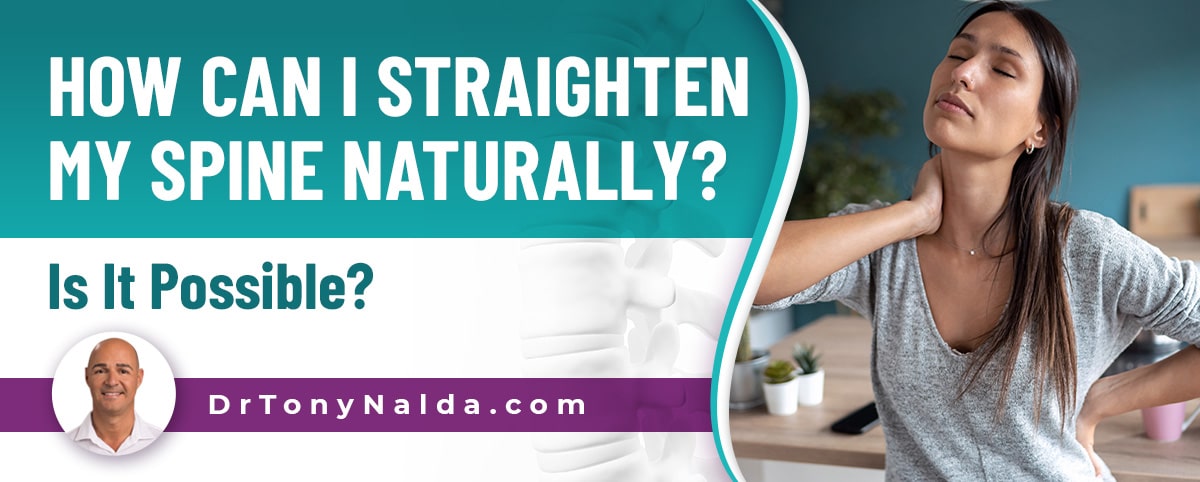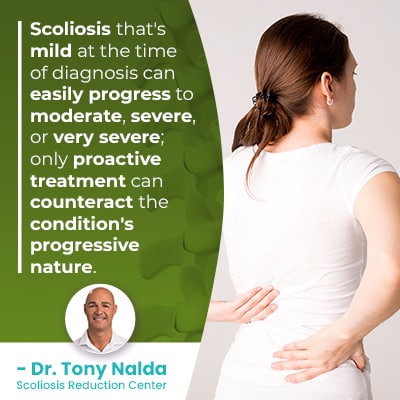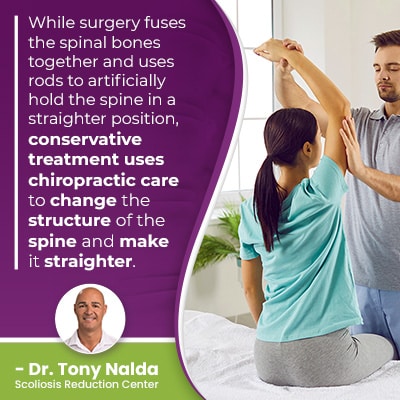How Can I Straighten My Spine Naturally? Is It Possible?

There are scoliosis treatment approaches that differ in their priorities and potential outcomes, which is why it's so important for patients to be informed of all treatment options available to them. While a scoliotic spine can be straightened through spinal fusion surgery, it can come at the cost of the spine's overall strength, health, and function.
When it comes to natural forms of scoliosis treatment, we're talking about the difference between a surgical response, and conservative non-surgical treatment. The spine can be straightened by invasive artificial means, or it can be straightened through corrective treatment that impacts the condition on a structural level.
Let's start our exploration of how to achieve a straight spine naturally by first defining scoliosis and the parameters that have to be met in order to reach a diagnosis of scoliosis.
Table of Contents
Being Diagnosed with Scoliosis
Scoliosis is a highly-prevalent spinal condition that can cause a myriad of symptoms that can affect the entire body.
Being diagnosed with scoliosis means an unnatural sideways spinal curve has developed, with rotation, and a minimum Cobb angle measurement of 10 degrees.
The rotational component is what makes scoliosis a 3-dimensional condition, as the spine doesn't just bend unnaturally to the side, but also twists from front to back, back to front.
The Cobb angle refers to a measurement taken during X-ray that involves drawing intersecting lines from the tops and bottoms of the curve's most-tilted vertebrae.
The resulting angle is expressed in degrees and places conditions on a severity scale:
- Mild scoliosis: Cobb angle measurement of between 10 and 25 degrees
- Moderate scoliosis: Cobb angle measurement of between 25 and 40 degrees
- Severe scoliosis: Cobb angle measurement of 40+ degrees
- Very-severe scoliosis: Cobb angle measurement of 80+ degrees
The higher the Cobb angle, the more misaligned the spine is, the more severe the condition, and the more likely it is to cause noticeable symptoms like postural deviation and pain.
However, compression-related pain is more common in adults as scoliosis doesn't become a compressive condition until skeletal maturity has been reached; until then, growing spines experience a constant lengthening motion that counteracts the compressive force of the unnaturally curved spine.
In addition, scoliosis is progressive, meaning it has it in its very nature to worsen over time, particularly if left untreated, or not treated proactively.
So where a scoliosis is at the time of diagnosis is not indicative of where it will stay.
 Scoliosis that's mild at the time of diagnosis can easily progress to moderate, severe, or very severe; only proactive treatment can counteract the condition's progressive nature.
Scoliosis that's mild at the time of diagnosis can easily progress to moderate, severe, or very severe; only proactive treatment can counteract the condition's progressive nature.
As such a highly-variable condition, scoliosis symptoms can include postural changes that present as poor posture, can affect walking posture, sitting posture, sleeping posture, standing position, core muscles, leg muscles, the ability to maintain even shoulder blades and keep shoulders straight, stand tall, and spinal pain.
When it comes to addressing scoliosis symptoms, the key is seeking professional medical advice, and treatment, that focuses on how to prevent scoliosis from getting worse.
In addition to different severity levels, there are also multiple types of scoliosis a person can develop.
Approximately 80 percent of known diagnosed scoliosis cases are classified as idiopathic, meaning not clearly associated with a single-known cause, while the remaining 20 percent are associated with known causes: neuromuscular, congenital, degenerative, and traumatic scoliosis.
So when it comes to scoliosis treatment options, what's the difference between straightening the spine artificially or naturally?
Scoliosis Treatment Options: Traditional and Conservative
There are two main scoliosis treatment approaches for patients to choose between: traditional and conservative.
The traditional approach to scoliosis treatment funnels patients towards spinal fusion because it's more reactive than proactive, while conservative treatment values proactive treatment started as close to the time of diagnosis as possible.
Traditional Scoliosis Treatment
Traditional treatment doesn't start treatment while a condition is mild, even though that's when it's at its most responsive to treatment, because it doesn't have a strategy for treating mild scoliosis: watching and waiting until a patient's condition progresses past the surgical-level threshold, becoming a candidate for scoliosis surgery.
Spinal fusion is an invasive surgical procedure that works towards straightening a scoliotic spine by fusing the most-tilted vertebra, at its apex, into one solid bone; this is done so movement (progression) is eliminated in the area.
Most often, rods are attached to the spine with screws to hold the spine straighter, but this is an artificial and unnatural response that can cost the spine in terms of its natural strength and function.
For example, one of the main complaints of patients who have opted for a surgical response to fix their curved spine is a significant loss in spinal flexibility and range of motion: something that can greatly impact quality of life.
Conservative Scoliosis Treatment
Conservative chiropractic-centered treatment evolved out of a greater understanding of scoliosis and treatment efficacy over the years and has provided patients, and their families, with a more natural way to achieve a straight spine.
Now, no spine is perfectly straight; in fact, the spine's natural curves make it stronger, more flexible, and better able to absorb/distribute mechanical stress incurred during movement.
When the spine loses one or more of its natural curves, its overall health, strength, function and biomechanics are disrupted.
A goal of conservative treatment is that by using a more-natural method to treat scoliosis, as much of the spine's natural function as possible is preserved, giving patients the best possible quality of life throughout treatment and beyond.
Here at the Scoliosis Reduction Center, I combine multiple condition-specific forms of treatment to impact the condition on every level.
 As a structural spinal condition, scoliosis has to be impacted, first and foremost, on a structural level, and this is the big difference between a surgical and non-surgical treatment response.
As a structural spinal condition, scoliosis has to be impacted, first and foremost, on a structural level, and this is the big difference between a surgical and non-surgical treatment response.
While surgery fuses the spinal bones together and uses rods to artificially hold the spine in a straighter position, conservative treatment uses chiropractic care to change the structure of the spine and make it straighter.
Through a series of chiropractic techniques and manual adjustments, I can work towards adjusting the position of the most-tilted vertebrae back into alignment with the rest of the spine; by doing so, the condition is impacted structurally, the condition's uneven forces are reduced alongside the curvature size, and the spine's biomechanics and function are improved.
Once I see structural results, I can shift the focus to increasing core strength so the spine is optimally supported by its surrounding muscles, and this can also help address muscle imbalance; a physical therapist who specializes in scoliosis-specific exercises can help with this.
Through corrective bracing, corrective results achieved through other treatment disciplines are complemented as the brace pushes the spine into a corrective position naturally and helps patients maintain good posture to improve spine health.
As the last phase of treatment, I custom-prescribe a series of specific exercises to help establish a home-rehabilitation program for further stabilizing the spine for long-term sustainable treatment results.
So while scoliosis surgery can be successful at straightening a crooked spine, it's not achieved through natural means, and this can mean that while the spine might be straighter, it's less strong, healthy, and functional.
Working towards improving spinal alignment through a series of chiropractic adjustments, maintaining good posture, strong back muscles, effective exercises, and rehabilitation provides a more-natural scoliosis treatment alternative.
Conclusion
For scoliosis patients experiencing related neck pain, tight muscles, bad posture, and a variety of spine problems related to their condition, it's important to understand the different potential outcomes offered by invasive and natural forms of treatment.
While scoliosis surgery was the dominant treatment choice for many years, a more-natural treatment alternative with proven results has emerged: conservative chiropractic-centered treatment.
Through combining multiple treatment disciplines that complement one another, I can help patients reduce their scoliotic curves on a structural level, without causing a loss in spinal health, strength, and function.
Through early detection and starting proactive treatment as close to the time of diagnosis as possible, I can work towards preventing progression, increasing condition severity, escalating symptoms, and the need for invasive surgical treatment in the future.
While a curvature reduction is always a priority of conservative treatment, finding ways to achieve it without adversely affecting the spine's function is key.
So while there are different methods for addressing spinal problems, the more natural, and less invasive they are, the more likely it is that improvements can be made for long-term sustainable results.
Dr. Tony Nalda
DOCTOR OF CHIROPRACTIC
After receiving an undergraduate degree in psychology and his Doctorate of Chiropractic from Life University, Dr. Nalda settled in Celebration, Florida and proceeded to build one of Central Florida’s most successful chiropractic clinics.
His experience with patients suffering from scoliosis, and the confusion and frustration they faced, led him to seek a specialty in scoliosis care. In 2006 he completed his Intensive Care Certification from CLEAR Institute, a leading scoliosis educational and certification center.
About Dr. Tony Nalda
 Ready to explore scoliosis treatment? Contact Us Now
Ready to explore scoliosis treatment? Contact Us Now





